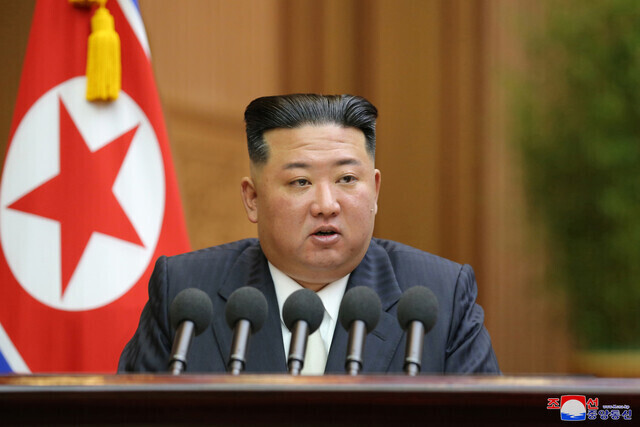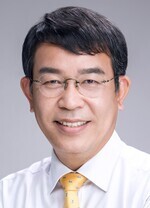hankyoreh
Links to other country sites 다른 나라 사이트 링크
[Column] Hinting at nuclear use is in vogue, and Kim Jong-un is staying on trend


At a defense development exhibition titled “Self-Defense-2021” held in Pyongyang last October, North Korean leader Kim Jong-un clearly stated that “our arch-enemy is the war itself, not south Korea, the United States or any other specific state or forces.”
“Undoubtedly, we are not strengthening our defence capability targeting at south Korea,” Kim emphasized, thus revealing that he would not preemptively attack the South with nuclear weapons. In other words, the purpose of North Korea’s nuclear power was not to obtain “victory” in war but to “deter” war in the first place.
During the Cold War, the fear of annihilation evoked by the destructive power of nuclear weapons created an order which negated the use of the weapons themselves.
Some strategists argued during the Cold War that “when nuclear weapons are not used, their strategic value increases,” calling this the “shadow politics” of nuclear weapons.
Last year, Kim Jong-un’s strategy was rooted in a deterrence theory that has been well-established since the Cold War.
However, Kim’s tone changed in a speech he gave at a military parade held at Kim Il-sung Square on April 25 this year.
“The fundamental mission of our nuclear forces is to deter a war, but our nukes can never be confined to the single mission of war deterrent even at a time when a situation we are not desirous of at all is created on this land,” Kim said, implying a dramatic change in his strategy.
“If any forces try to violate the fundamental interests of our state, our nuclear forces will have to decisively accomplish its unexpected second mission,” Kim continued, showing a willingness to use his country’s nuclear weapons.
Then, on Sept. 8, Kim Jong-un’s address to the Supreme People's Assembly led to the enactment of a new law regarding the country’s nuclear weapons. The law includes details such as the command-and-control structure of the country’s nuclear forces as well as decision procedures and conditions for using these nuclear weapons.
The law stipulates that “a nuclear strike shall be launched automatically and immediately” in case “the command and control system over the state nuclear forces is placed in danger owing to an attack by hostile forces.”
Why did Kim Jong-un change his strategy in such a way? Was he moved by an adventurous impulse? Let’s take a step back to get a wider look at this situation by examining it from a more global perspective.
On the same day of North Korea's military parade, Russia’s Foreign Minister Sergei Lavrov said in an interview with Russian state TV that the risks of nuclear war are now “considerable,” and that the danger is “serious, real.”
Following Putin’s declaration of holding a nuclear readiness posture in March, these were all signals that tactical nuclear weapons could be used in real combat regardless of the old Cold War deterrence theory framework.
It was also around this time that strategists from the West observed that Russia, which has more than 2,000 tactical nuclear warheads — 10 times more than the US — was planning to deploy these weapons to the country’s western region in order to threaten Europe.
Suddenly, nuclear weapons had now become an existential threat rather than a mere shadow of one, and the threshold for nuclear war was significantly lowered.
But it’s not just Russia. The US also began developing a series of nuclear weapons called low-yield nuclear weapons or non-strategic nuclear weapons under President Trump. They include thermonuclear gravity bombs that are dropped by aircraft, nuclear cruise missiles, and short-range nuclear submarine-launched missiles.
This move to stockpile nuclear weapons that are likely to be used in real conflict marked a real shift in the way of thinking about them.
Although President Joe Biden temporarily halted the further development of such weapons, Trump's nuclear policy did have a major impact on South Korea.
Some South Korean strategists believe that the combination of US low-yield nuclear weapons with South Korea’s three-axis defense system could make for an effective or “expanded” deterrent against North Korea. As a result, such strategists were drawn to this so-called “customized” nuclear use strategy of sharing tactical nuclear weapons with the US.
Meanwhile, in an interview with Japanese media in April, Sugio Takahashi, head of defense policy at Japan’s National Institute for Defense Studies, argued that the world's perception is changing from “nuclear weapons become a deterrent if they exist” to “without the premise of using nuclear weapons, they have no deterring power.”
This is an argument implying that the third era of nuclear weapons use could be imminent. The first nuclear era refers to when nuclear bombs were dropped on Japan, while the second denotes the period of “shadow politics” of nuclear weapons during the Cold War.
Moreover, Japan has also recently been considering a new defense policy, including securing the ability to strike enemy bases and sharing tactical nuclear weapons with the US.
Given these international developments, it would be strange for North Korea not to have the strategic sense to pick up on these changing trends.
Indeed, while referring to the “sudden changes” in the international situation, North Korea has been refining its own nuclear strategy by swiftly gathering and analyzing the latest nuclear-related trends.
The urge to use the nuclear weapons one possesses does not only apply to great powers.
North Korea, which is trying to find a way out of its current difficulties through a strategic alliance with Russia, has broken its own previously adhered to nuclear principles and switched to a more preemptive and aggressive nuclear strategy than Russia.
The logic behind the strategy is that the enemy can only be suppressed if the other side shows true determination to engage in a nuclear war.
The bellicose genes of our predecessors who said they would rather “blow up the earth” than lose a war are evolving in a modern way.
Please direct questions or comments to [english@hani.co.kr]

Editorial・opinion
![[Column] Park Geun-hye déjà vu in Yoon Suk-yeol [Column] Park Geun-hye déjà vu in Yoon Suk-yeol](https://flexible.img.hani.co.kr/flexible/normal/500/300/imgdb/original/2024/0424/651713945113788.jpg) [Column] Park Geun-hye déjà vu in Yoon Suk-yeol
[Column] Park Geun-hye déjà vu in Yoon Suk-yeol![[Editorial] New weight of N. Korea’s nuclear threats makes dialogue all the more urgent [Editorial] New weight of N. Korea’s nuclear threats makes dialogue all the more urgent](https://flexible.img.hani.co.kr/flexible/normal/500/300/imgdb/original/2024/0424/7317139454662664.jpg) [Editorial] New weight of N. Korea’s nuclear threats makes dialogue all the more urgent
[Editorial] New weight of N. Korea’s nuclear threats makes dialogue all the more urgent- [Guest essay] The real reason Korea’s new right wants to dub Rhee a founding father
- [Column] ‘Choson’: Is it time we start referring to N. Korea in its own terms?
- [Editorial] Japan’s rewriting of history with Korea has gone too far
- [Column] The president’s questionable capacity for dialogue
- [Column] Are chaebol firms just pizza pies for families to divvy up as they please?
- [Column] Has Korea, too, crossed the Rubicon on China?
- [Correspondent’s column] In Japan’s alliance with US, echoes of its past alliances with UK
- [Editorial] Does Yoon think the Korean public is wrong?
Most viewed articles
- 1‘We must say no’: Seoul defense chief on Korean, USFK involvement in hypothetical Taiwan crisis
- 2N. Korean delegation’s trip to Iran shows how Pyongyang is leveraging ties with Moscow
- 3‘Weddingflation’ breaks the bank for Korean couples-to-be
- 4Korea sees more deaths than births for 52nd consecutive month in February
- 546% of cases of violence against women in Korea perpetrated by intimate partner, study finds
- 6[Column] Park Geun-hye déjà vu in Yoon Suk-yeol
- 7Will NewJeans end up collateral damage in internal feud at K-pop juggernaut Hybe?
- 8Amnesty notes ‘erosion’ of freedom of expression in Korea in annual human rights report
- 9[Editorial] New weight of N. Korea’s nuclear threats makes dialogue all the more urgent
- 10[Column] Yoon’s first 100 days should open our eyes to pitfalls of presidential system